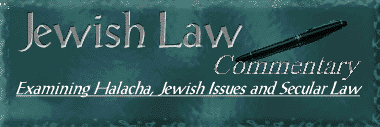

Dropout Prevention: An IDEA
Chaim Dovid Zwiebel
Dropout Prevention: An IDEA
by Chaim Dovid Zwiebel
In the Spring of 1991, Paul and Patricia Russman arrived at an important decision.
Their daughter Colleen, then 10 years old, had been diagnosed five years earlier as requiring special education services and had been placed in a school for the handicapped operated by their local school district in upstate New York. Now, however, with Colleen having demonstrated promising educational progress, the Russmans decided that the time had come to have her "mainstreamed" into a regular classroom setting.
The school district's Committee on Special Education agreed. The Committee, authorized by law to develop an "Individualized Educational Program" for educationally handicapped children, devised an IEP to give Colleen the assistance she would need to succeed in a regular classroom: a consultant teacher to work with the regular teacher in adapting the classroom curriculum, a teaching aide to assist Colleen directly with her studies, and a program of speech and occupational therapy. These services would be provided, free of charge to the Russmans, at the local public school.
But the Russmans were not interested in the local public school. They wanted to enroll Colleen in the school her two sisters attended: St. Brigid's Regional Catholic School. The school district countered that it had no legal obligation to provide special education services on the premises of a religious school -- indeed, that to do so would be an impermissible breach of the constitutional wall separating "church and state".
Thus was the stage set for a legal battle that could well have enormous implications for our own Orthodox Jewish community.
Unfulfilled Promise
In the 1970's, Congress passed the "Individuals with Disabilities Education Act", commonly known as IDEA, whose purpose was to "assure that all children with disabilities have available to them ... a free appropriate public education which emphasizes special education and related services designed to meet their unique needs."
The statute's reference to "public education" does not mean to limit the benefits of the law exclusively to children enrolled in public schools. Thus, where there is no "appropriate" special education program in the public sector to meet a child's particular needs, the law requires the school district to pay the full cost of the child's placement in an appropriate non-public setting. Even where a public school is able to meet the child's needs, if his parents choose voluntarily to place him in a non-public school -- as the Russmans did -- the school district must pay for special education services that are "comparable in quality, scope, and opportunity for participation to the program benefits that the [school district] provides for students enrolled in public schools."
Unfortunately, however, children requiring special education services in religious schools have enjoyed only minimal benefit under the law. Special education services are expensive, and financially strapped school districts have had their budgetary hands full just trying to keep up with the needs of handicapped children in the public schools. Many districts have thus developed legal arguments to relieve themselves of the obligation to service children on the premises of religious schools, instead insisting that such children go to their local public schools or some other "neutral site" to receive special education.
The bottom line is hardly surprising: Many parents who send their children to religious schools never even bother to have their children seen by their local Committee on Special Education, and those who do often have little or nothing to show for their effort.
A Precedent-Setting Ruling
But in June of this year, faced with the Russmans' claim to have Colleen serviced at a religious school, the U.S. Court of Appeals for the Second Circuit issued a decision that could well alter that bottom line.
The court determined, first, that the constitution does not prohibit publicly funded special education services on the premises of religious schools; and, second, that the federal law affirmatively requires that IDEA services be provided on religious school premises, unless the cost of servicing children at a religious school site would be greater than it would be at a public school site. "We therefore hold," concluded the court, "that the IDEA requires the school district to provide Colleen with the consultant and aide at St. Brigid's."
The court of appeals ruling may not be the final word on the subject. Other tribunals -- most notably, the federal appeals courts for the Fourth and Seventh Circuits -- have interpreted the law less favorably toward non-public school students; a definitive interpretation may have to await Supreme Court consideration. For now, though, the Russman decision is binding on school districts throughout New York, Connecticut and Vermont -- the three states over which the Second Circuit has jurisdiction -- and provides persuasive precedent nationally.
The Seeds of Solution?
Readers of the Jewish Observer have become well acquainted in recent months with the heartrending problem of "teen-age dropouts" in our midst -- children and young adults from wonderful families who somehow do not find their place within the Jewish school system and tragically drift away from their yeshivos and Bais Yaakovs, sometimes even from their families and communities. It is no secret: Far too many children founder in yeshiva settings.
It is no secret, and it is no wonder. If anything, given the realities of the modern day yeshiva system -- the physically and intellectually demanding burden the dual program of limudei kodesh and secular studies imposes on even the most gifted students, the typically large class size that often makes it impossible for even the best qualified rabbeim and teachers to devote personalized attention to students who require special assistance -- it is nothing less than an extraordinary manifestation of siyata d'Shmaya that so few of our children fall by the educational and spiritual wayside.
Not all "teen-age dropouts" in our community suffer from learning disabilities. But many surely do -- experts estimate that approximately 10% of all school children are learning disabled -- and many never receive appropriate special education services. It is presumptuous, perhaps, to suggest that their lives would have turned out differently with such services. But it is also foolhardy to dismiss the possibility.
Shortly after the Russman decision, my Agudath Israel colleagues Mordechai Avigdor and Deborah Jacob circulated a memo urging yeshivos in New York and across the country to encourage parents of educationally handicapped children to "have their children evaluated by their local committees on special education and request that services identified in their individualized education program be provided on-site at the yeshiva."
The problem is apparent. The solution, for at least some of our at-risk youngsters, may well be at hand.
Copyright © 1997-2008 by Ira Kasdan. All rights reserved.
DISCLAIMER